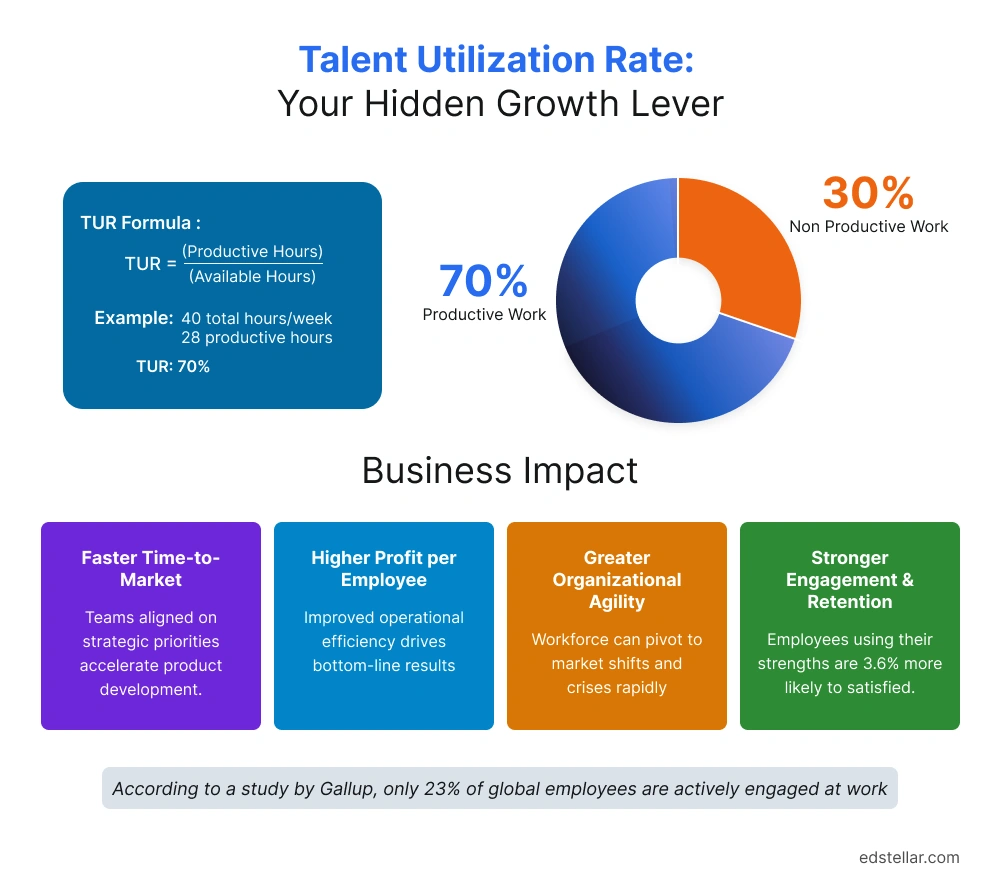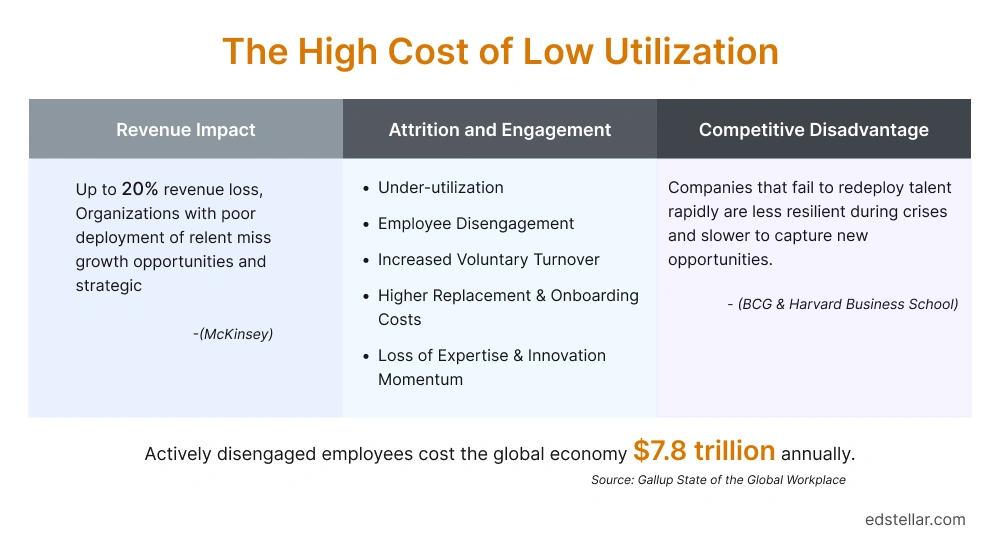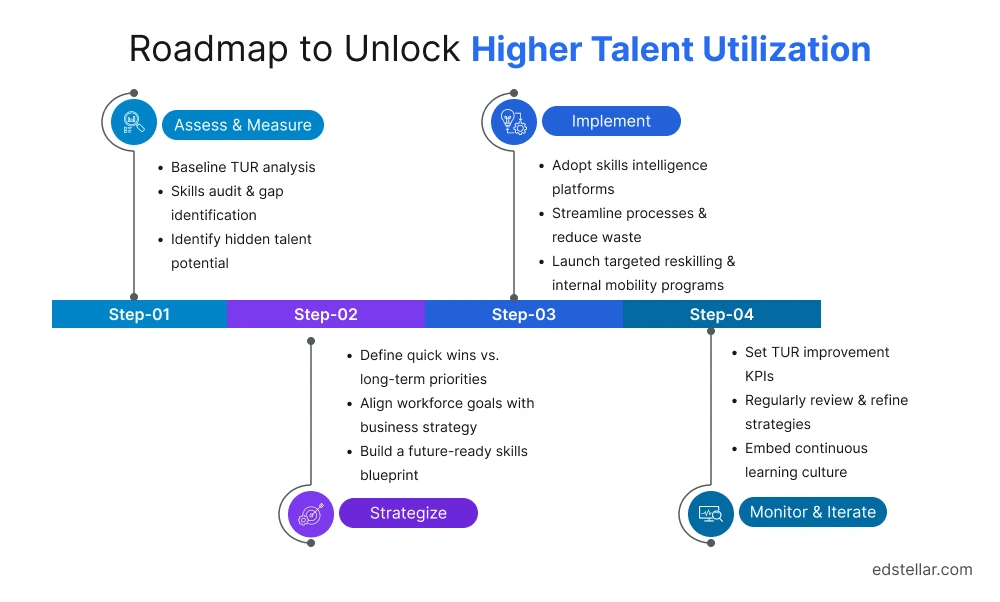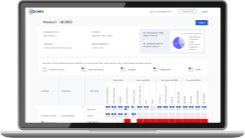
In executive boardrooms, leaders meticulously track metrics like revenue per employee, EBITDA margins, and customer lifetime value to assess performance. But there’s a critical measure often missing from this data-driven scrutiny: Talent Utilization Rate (TUR).
At first glance, TUR may seem like an operational detail best left to HR or line managers. Yet, when viewed through a strategic lens, it reveals an organization's ability to deploy its most valuable asset, human capital, to its highest potential.
A recent McKinsey study underscores that companies maximizing talent deployment achieve up to 22% higher profitability, as they leverage skills strategically rather than merely tracking generic productivity. Deloitte further points out that traditional productivity metrics often fail to capture the true value of talent when misaligned with strategic priorities, limiting both innovation and growth capacity.
In today’s environment defined by rapid digital transformation, evolving customer demands, and global talent shortages, the ability to optimize talent utilization has emerged as a decisive competitive advantage. It is no longer enough for teams to be busy; they must be busy doing the right work that drives strategic outcomes.
“Are your people engaged in activities that move the business forward, or just keeping the lights on?”
Organizations that can answer this question with confidence consistently outperform peers in adaptability, innovation velocity, and financial resilience.
TUR, therefore, is not just an HR efficiency metric; it is a leadership imperative that directly shapes profitability, market positioning, and long-term growth.
Understanding Talent Utilization Rate: More Than Just a Number
At its core, Talent Utilization Rate is a metric that measures the percentage of an employee’s available time that is actively spent on productive, value-generating tasks.
Formula:
For example, if a software engineer has 40 available work hours per week, and only 28 of those are spent on project work (with the rest consumed by meetings, admin, or idle time), their talent utilization rate is 70%.
However, unlike capacity utilization or labor productivity, which measure overall output, TUR focuses specifically on how effectively human potential is being utilized. This makes it a uniquely strategic indicator that reflects both organizational design and individual alignment.

Why It Matters:
According to a study by Gallup, only 23% of global employees are actively engaged at work. One major driver? Employees feel underutilized or misaligned with their roles.
When talent isn’t utilized effectively:
- Projects get delayed.
- Top performers burn out while others coast.
- Innovation stagnates as skilled minds are left idle or mismatched.
The Outcomes of High Talent Utilization
When organizations get TUR right, the outcomes are measurable and transformative:
Faster time-to-market
- Highly utilized talent is directly engaged in critical projects.
- Accelerates product development and innovation pipelines.
- McKinsey emphasizes that companies with modern, talent-centric operating models built around clarity, speed, skills, and commitment consistently bridge the gap between strategy and performance more effectively.
Improved profitability
- Higher TUR drives better profit per employee and operational efficiency.
- McKinsey research shows that organizations centered on talent outperform competitors in revenue per employee and total shareholder return.
Greater employee engagement and retention
- Employees working on tasks that match their strengths report higher motivation and loyalty.
- Workers given the chance to fully apply their skills are 3.6 times more likely to be satisfied in their jobs.
Enhanced organizational agility
- A workforce operating at high utilization adapts more quickly to shifting priorities.
- Improves the organization's ability to respond to market changes, disruptions, and emerging opportunities.
The Strategic Importance of TUR in Modern Enterprises
When we talk about talent as an “asset,” we often forget that any asset, if underutilized, becomes a liability. Just as idle manufacturing equipment drags down operational efficiency, under-deployed talent erodes organizational resilience and adaptability.
The World Economic Forum’s Future of Jobs Report 2023 highlighted that companies capable of agilely shifting talent to new priorities outperform competitors during crises and market shifts. During the COVID-19 pandemic, organizations with dynamic talent reallocation strategies were able to redeploy up to 20% of their workforce to emerging business-critical areas, a feat impossible without a clear understanding of utilization.
Atlassian’s Talent Sprint: A Blueprint for Agile Redeployment
In the tech sector, Atlassian serves as a striking example. Faced with rapidly shifting demands for collaboration tools, the company undertook a radical re-mapping of its internal talent, identifying hidden skills within the engineering and customer success teams. Through what they called “Skills Marketplace Sprints,” Atlassian temporarily shifted hundreds of employees to innovation and feature acceleration projects, increasing product release velocity by over 25% during the first half of 2020.
Talent Utilization Rate vs. Productivity: Why Leaders Must See the Distinction
Executives often obsess over productivity metrics, outputs per hour, revenue per head, and project velocity. While these are valuable snapshots, they tell only half the story. They reveal how much work is getting done, but not how strategically aligned or impactful that work actually is.
Talent Utilization Rate (TUR) introduces a more sophisticated question:
“Are our people applying their highest-value skills to the most strategically important work?”
In other words, TUR shifts the focus from simple volume to value. Productivity might measure the number of lines of code written, client calls made, or reports produced. But if these activities don’t leverage employees' true strengths or don’t contribute meaningfully to strategic objectives, they can quickly become “busy work” rather than business-critical contributions.
Key Pitfall: The Cost of Overvaluing Productivity Alone
When organizations chase raw productivity without considering talent utilization, they often create hidden costs and organizational friction:
- Burnout Dressed as Efficiency: People log extra hours not because they’re engaged, but to fill gaps in unclear task allocation. Harvard Business Review reports that knowledge workers spend nearly 80% of their time in meetings or responding to colleagues, not core tasks, which leads to fatigue and diminished engagement.
- Retention Risk Among Top Performers: When high performers carry disproportionate workloads, retention suffers. Gallup finds that employees who frequently experience burnout are 2.6 times more likely to be seeking a new job.
- Innovation Suffers Under Weight of Busy Work: McKinsey found that companies overly focused on daily outputs often deprioritize innovation, delaying or derailing essential transformational projects.
The High Cost of Low Talent Utilization: What’s at Stake?
When leaders think about performance gaps, they often look at sales targets missed or delayed projects. But below these surface issues lies a deeper structural problem: low Talent Utilization Rate (TUR).
While it may not show up directly on financial statements, low TUR silently undermines revenue, increases attrition risk, and erodes competitive advantage. Let’s unpack why.

Revenue Impact
Low utilization results in under-leveraging high-value skills, meaning fewer strategic initiatives move forward, and revenue potential goes unrealized.
According to McKinsey, organizations with poor deployment of talent can lose up to 20% of potential revenue, often due to misaligned skills and underused capabilities.
Moreover, BCG identifies “adaptive” firm those that redeploy talent fluidly as consistently outperforming their market peers financially.
Attrition and Engagement
Underutilization is one of the top drivers of disengagement and voluntary turnover.
When employees, especially high performers, feel their strengths are wasted or overlooked, they become demotivated and look elsewhere. This is more than just a retention problem it’s a competitive threat. Gallup data shows employees that actively disengaged cost the global economy of $7.8 trillion in lost productivity annually.
Competitive Disadvantage
In an era of rapid market shifts, organizations must reallocate talent fluidly to emerging priorities, whether it’s a new digital product launch, M&A integration, or sudden crisis response.
Harvard Business School and BCG note that workforce ecosystems and flexible internal talent deployment drive resilience and innovation.
Companies stuck in rigid staffing models struggle to pivot, leaving them vulnerable to disruption and less able to seize new opportunities.
Case Study: Cisco’s Workforce Redeployment Playbook
Overview
Faced with rapid shifts in technology and increased demand for cloud and security solutions, Cisco recognized that its existing talent was heavily siloed within legacy business units. Engineers and product specialists were often tied to outdated roles, leaving critical innovation teams understaffed and slowing the company’s pivot to emerging markets.
To address this, Cisco launched a large-scale workforce redeployment initiative. This strategic move leveraged AI-powered internal talent marketplaces and advanced skills mapping to dynamically match employees to high-priority growth areas.
Measurement Approach
- Skills Mapping via AI: Continuously assessed over 7,000 employees to match them with upcoming projects efficiently.
- Internal Mobility Tracking: Monitored how swiftly and effectively employees moved into new roles.
- Engagement and Retention Surveys: Regular pulse checks measured satisfaction and voluntary turnover among technical talent.
Outcomes
- 3,000+ employees redeployed, resulting in a 23% acceleration in product development.
- 14% reduction in voluntary attrition among engineering teams.
- $200 million saved by reducing external hiring and onboarding costs.
- Cisco’s agile talent deployment model was spotlighted in a study by MIT Sloan Management Review as a benchmark for workforce agility and transformation
Key Takeaway:
Cisco’s example underscores that talent utilization is not just about efficiency; it’s about strategic agility. Proactively redeploying talent ensures that critical skills fuel growth areas, directly impacting innovation, cost efficiency, and employee engagement.
Key Factors That Impact Your Talent Utilization Rate
Identifying what’s dragging down your TUR is often more important than simply measuring it. While each organization has unique friction points, several core drivers are consistently at play.
Skills Gaps and Mismatches
When employees lack the right skills or aren’t matched to tasks that fully leverage their capabilities, utilization plummets. According to the World Economic Forum, only 44% of workers’ core skills are expected to change by 2027.
Companies failing to track and bridge these gaps risk leaving vast amounts of talent potential untapped.
Operational Bottlenecks
Process inefficiencies can devour a shocking percentage of work time. A survey by Asana showed that the average knowledge worker spends only 33% of their time on actual skilled work the rest is lost to meetings, duplication, and searching for information. Streamlining workflows and improving cross-team visibility are crucial to reclaiming this lost time.
Cultural and Leadership Dynamics
Culture can either unlock or suppress utilization. When feedback is stifled, when leaders micromanage, or when risk-taking is discouraged, employees revert to "safe," low-impact tasks rather than pushing strategic initiatives forward.
Companies with strong feedback and trust cultures, like Adobe, experience significantly higher innovation output and employee engagement scores.
Strategies to Improve Talent Utilization Rate: From Theory to Action
Recognizing the problem is step one; the real value lies in actionable strategies that can move TUR from a conceptual metric to a strategic advantage.

1. Build a Dynamic Skills Inventory
Rather than static spreadsheets or outdated competency maps, dynamic skills inventories continuously evolve based on real-time project data, manager feedback, and self-reported learning.
A great example is Unilever’s AI-powered internal talent marketplace, which dynamically suggests projects or temporary roles to employees based on evolving skill sets and interests. As a result, the company has seen faster talent redeployment and higher internal mobility, significantly improving overall workforce agility.
2. Redesign Processes to Cut Waste
Instead of “more meetings,” many leading organizations move toward transparent, asynchronous updates and streamlined decision-making structures. Process mining tools like Celonis can map digital workflows and surface bottlenecks in ways that traditional process audits cannot.
3. Invest in Continuous Skills Development
It’s not just about formal training but about embedding learning into daily work. Forward-thinking companies like Amazon provide "Career Choice" programs that fund reskilling in high-demand areas even outside the company’s immediate needs, driving loyalty and future-proofing the workforce (Amazon Career Choice Program).
4. Foster Internal Mobility and Cross-Functional Experiences
Schneider Electric’s “Open Talent Market” initiative lets employees proactively pitch for internal projects, increasing engagement and utilization. This approach reduced the time to staff strategic projects by 80% and boosted employee satisfaction.
Case Study: IBM’s Skills-First Talent Transformation
Overview
IBM, facing accelerating shifts in cloud computing and AI, recognized that traditional job-based staffing models limited its ability to innovate and respond to new market opportunities. To overcome this, IBM launched a major “skills-first” transformation initiative. Central to this approach was creating a digital credential system (known as “badges”) to document and verify employees’ skills globally.
Measurement Approach
- Digital Skills Inventory: Mapped over 7,000 unique skills across the global workforce using verified digital badges.
- Internal Mobility Tracking: Monitored employee transitions into new roles and projects to assess agility and redeployment speed.
- Hiring and Cost Analysis: Measured reduction in external hiring needs and associated cost savings to quantify ROI.
Outcomes
- Reduced external hiring needs by 30%, saving approximately $450 million annually.
- Increased internal mobility by 20%, enabling employees to shift into high-growth areas.
- Strengthened strategic pivots into emerging fields such as quantum computing and cybersecurity, enhancing IBM’s market leadership and innovation capacity.
Technology as a Catalyst for TUR
Adopting advanced technology is no longer optional if you want to unlock true talent utilization potential.
Skills Intelligence Platforms
AI-powered platforms integrate learning data, project records, and performance reviews to provide a live view of workforce capabilities. This allows managers to allocate the best-fit talent dynamically, rather than relying on historical assumptions or biased gut feelings.
Predictive Analytics
Beyond the present state, predictive models can forecast future utilization needs and skill shortages, allowing for proactive workforce planning. This predictive approach has helped Microsoft identify critical skills gaps in cybersecurity teams, enabling early training investments to strengthen defenses and improve incident response capabilities.
Final Thoughts: Your Competitive Edge Lies in Talent Utilization
Maximizing talent utilization is not about pushing employees to their limits; it’s about enabling them to contribute where they have the most impact and derive the most meaning.
By viewing TUR as a strategic lever rather than an HR metric, leaders can:
- Accelerate digital transformation and market agility
- Attract and retain top talent
- Drive sustained profitability and innovation
Where Edstellar Can Help
As business leaders shift their focus beyond traditional productivity metrics, they recognize that fully unlocking the potential of their workforce is no longer just an HR initiative it is a critical business imperative. Yet achieving this requires far more than static competency frameworks or fragmented training catalogs. Edstellar’s Skills Intelligence Platform enables organizations to bridge this gap through a data-driven, AI-powered approach to talent optimization.
With real-time, dynamic visibility into your workforce’s capabilities, leaders gain the insight needed to uncover hidden strengths and strategically deploy people where they can create the greatest impact.
By connecting employees to high-impact projects that align with their expertise and aspirations, organizations accelerate critical initiatives and foster a culture of purpose-driven work. This targeted approach not only supports business priorities more effectively but also inspires stronger engagement and loyalty, as employees see clear pathways for growth and meaningful contribution.
In addition, Edstellar’s platform enables companies to proactively close skills gaps through focused, future-aligned upskilling, moving beyond generic training and empowering teams to adapt to market shifts and emerging challenges confidently. At a time when agility and innovation are essential for competitive advantage, Edstellar helps turn underutilized potential into measurable business value. The result is a more resilient and adaptive organization, prepared to succeed in a fast-changing world.
Explore our Skills Matrix to better understand your current talent landscape, and browse our 2,000+ corporate training programs to start building a workforce that is fully equipped for the future.
Explore High-impact instructor-led training for your teams.
#On-site #Virtual #GroupTraining #Customized

Bridge the Gap Between Learning & Performance
Turn Your Training Programs Into Revenue Drivers.
Schedule a ConsultationEdstellar Training Catalog
Explore 2000+ industry ready instructor-led training programs.

Coaching that Unlocks Potential
Create dynamic leaders and cohesive teams. Learn more now!


Want to evaluate your team’s skill gaps?
Do a quick Skill gap analysis with Edstellar’s Free Skill Matrix tool

Transform Your L&D Strategy Today
Unlock premium resources, tools, and frameworks designed for HR and learning professionals. Our L&D Hub gives you everything needed to elevate your organization's training approach.
Access L&D Hub Resources.svg)
.svg)



.svg)


.svg)
.svg)
.svg)
.svg)

